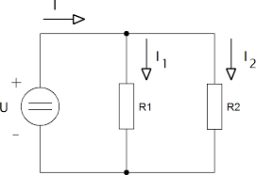Resistance 80351
We connected two resistors in parallel in the circuit, with the first having three times the resistance of the second. The voltage between the terminals of each resistor is 6 V. Calculate the current through each branch when the resulting resistance of both resistors is 15 ohms.
Final Answer:

Tips for related online calculators
Check out our ratio calculator.
You need to know the following knowledge to solve this word math problem:
algebrabasic operations and conceptsthemes, topicsGrade of the word problem
Related math problems and questions:
- Two resistors 5
 Two resistors are connected in parallel. The first resistor has a resistance of 2000 ohms and a current of 4 mA flows through it. The second resistor has a resistance of 1600 ohms. 1/Draw a circuit diagram 2/Determine the voltage of the power source. 3/Wh
Two resistors are connected in parallel. The first resistor has a resistance of 2000 ohms and a current of 4 mA flows through it. The second resistor has a resistance of 1600 ohms. 1/Draw a circuit diagram 2/Determine the voltage of the power source. 3/Wh - Resistor
 Resistor 1, with a resistance of 100 Ohms, and resistor 2, with a resistance of 400 Ohms, are connected side by side in the circuit. The voltage between the resistor terminals is 80V. a) Draw a circuit diagram and write the entered quantities in it b) Fin
Resistor 1, with a resistance of 100 Ohms, and resistor 2, with a resistance of 400 Ohms, are connected side by side in the circuit. The voltage between the resistor terminals is 80V. a) Draw a circuit diagram and write the entered quantities in it b) Fin - Serial resistors
 In the circuit shown ( two resistors, R1 and R2, serially connected), the total resistance from A to B is 16 ohms. If the voltage between A and B is 10 V, find the resistance R2 and the current through the R1 = 12-ohm resistor.
In the circuit shown ( two resistors, R1 and R2, serially connected), the total resistance from A to B is 16 ohms. If the voltage between A and B is 10 V, find the resistance R2 and the current through the R1 = 12-ohm resistor. - Electrical 61534
 A current of 5 mA flows through a resistor with an electrical resistance of 600 Ω. What electrical voltage do we measure between the resistor terminals?
A current of 5 mA flows through a resistor with an electrical resistance of 600 Ω. What electrical voltage do we measure between the resistor terminals? - Resistance
 A resistor having an electrical resistance of 1.5 k ohms passes an electrical current of 0.1 A. Calculate the voltage between the terminals of the resistor.
A resistor having an electrical resistance of 1.5 k ohms passes an electrical current of 0.1 A. Calculate the voltage between the terminals of the resistor. - A current
 A current of 0.1 A flows in the branch with a resistance of 5 ohms. In the second branch, a current of 0.2 A. Calculate: a) what is the resistance of the second branch, b) to what voltage was the circuit connected?
A current of 0.1 A flows in the branch with a resistance of 5 ohms. In the second branch, a current of 0.2 A. Calculate: a) what is the resistance of the second branch, b) to what voltage was the circuit connected? - Electrical 5719
 A resistor with an electrical resistance of 1.5 kiloohms passes through an electrical current of 0.1 amps. Calculate the electrical voltage between the resistor terminals
A resistor with an electrical resistance of 1.5 kiloohms passes through an electrical current of 0.1 amps. Calculate the electrical voltage between the resistor terminals
